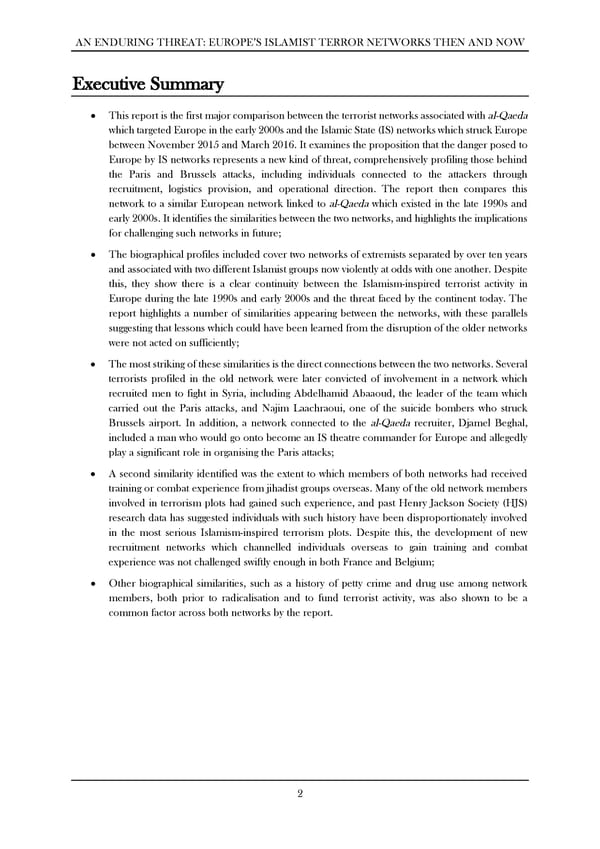AN ENDURING THREAT: EUROPE’S ISLAMIST TERROR NETWORKS THEN AND NOW Executive Summary •! This report is the first major comparison between the terrorist networks associated with al-Qaeda which targeted Europe in the early 2000s and the Islamic State (IS) networks which struck Europe between November 2015 and March 2016. It examines the proposition that the danger posed to Europe by IS networks represents a new kind of threat, comprehensively profiling those behind the Paris and Brussels attacks, including individuals connected to the attackers through recruitment, logistics provision, and operational direction. The report then compares this network to a similar European network linked to al-Qaeda which existed in the late 1990s and early 2000s. It identifies the similarities between the two networks, and highlights the implications for challenging such networks in future; •! The biographical profiles included cover two networks of extremists separated by over ten years and associated with two different Islamist groups now violently at odds with one another. Despite this, they show there is a clear continuity between the Islamism-inspired terrorist activity in Europe during the late 1990s and early 2000s and the threat faced by the continent today. The report highlights a number of similarities appearing between the networks, with these parallels suggesting that lessons which could have been learned from the disruption of the older networks were not acted on sufficiently; •! The most striking of these similarities is the direct connections between the two networks. Several terrorists profiled in the old network were later convicted of involvement in a network which recruited men to fight in Syria, including Abdelhamid Abaaoud, the leader of the team which carried out the Paris attacks, and Najim Laachraoui, one of the suicide bombers who struck Brussels airport. In addition, a network connected to the al-Qaeda recruiter, Djamel Beghal, included a man who would go onto become an IS theatre commander for Europe and allegedly play a significant role in organising the Paris attacks; •! A second similarity identified was the extent to which members of both networks had received training or combat experience from jihadist groups overseas. Many of the old network members involved in terrorism plots had gained such experience, and past Henry Jackson Society (HJS) research data has suggested individuals with such history have been disproportionately involved in the most serious Islamism-inspired terrorism plots. Despite this, the development of new recruitment networks which channelled individuals overseas to gain training and combat experience was not challenged swiftly enough in both France and Belgium; •! Other biographical similarities, such as a history of petty crime and drug use among network members, both prior to radicalisation and to fund terrorist activity, was also shown to be a common factor across both networks by the report. ! ! 2 !
 An Enduring Threat: Europe’s Islamist Terror Networks Then and Now Page 3 Page 5
An Enduring Threat: Europe’s Islamist Terror Networks Then and Now Page 3 Page 5